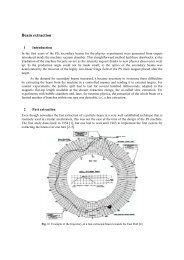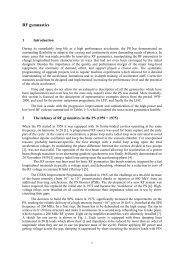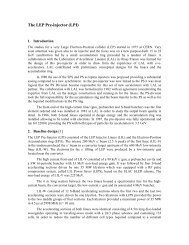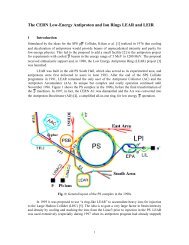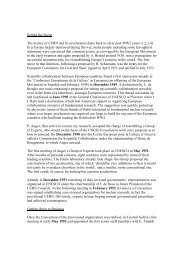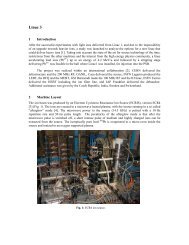Linac2 - 50th anniversary of the CERN Proton Synchrotron
Linac2 - 50th anniversary of the CERN Proton Synchrotron
Linac2 - 50th anniversary of the CERN Proton Synchrotron
You also want an ePaper? Increase the reach of your titles
YUMPU automatically turns print PDFs into web optimized ePapers that Google loves.
eam, so far <strong>the</strong> highest intensity reached by an operational RFQ. Longitudinal matching to <strong>the</strong><br />
Alvarez DTL is performed by two bunching cavities. Fig. 3 shows <strong>the</strong> RFQ as installed in front <strong>of</strong> <strong>the</strong><br />
<strong>Linac2</strong> tanks.<br />
Fig. 3: RFQ2 and <strong>Linac2</strong> tanks.<br />
During <strong>the</strong> first years after installation, <strong>the</strong> RFQ was operated at voltages slightly below<br />
nominal in order to limit RF breakdowns to levels compatible with <strong>the</strong> reliability required for <strong>the</strong><br />
<strong>CERN</strong> injector. This in turn limited <strong>the</strong> beam current from <strong>the</strong> RFQ to values around 180 mA. The<br />
progressive upgrade and cleaning <strong>of</strong> <strong>the</strong> vacuum system allowed reaching <strong>the</strong> design voltage a few<br />
years after installation, with <strong>the</strong> RFQ delivering beam currents in excess <strong>of</strong> 200 mA, which correspond<br />
to currents in excess <strong>of</strong> 180 mA at <strong>the</strong> exit <strong>of</strong> <strong>the</strong> linac.<br />
O<strong>the</strong>r improvements to <strong>Linac2</strong> after construction were mainly aimed at keeping <strong>the</strong> required<br />
reliability and to adapt to <strong>the</strong> evolving technologies. These included <strong>the</strong> commissioning <strong>of</strong> a new<br />
control system in 1993, <strong>the</strong> installation <strong>of</strong> new low-power solid state amplifiers and <strong>the</strong> replacement <strong>of</strong><br />
<strong>the</strong> interlocks and <strong>of</strong> <strong>the</strong> electronics <strong>of</strong> <strong>the</strong> high-power amplifiers on <strong>the</strong> RF systems.<br />
4 Conclusions<br />
It was <strong>the</strong> rapid progress in linac technology that made possible <strong>the</strong> replacement <strong>of</strong> Linac1 after 20<br />
years <strong>of</strong> operation with <strong>the</strong> new <strong>Linac2</strong>, providing a factor 2 increase in both current and pulse length,<br />
with <strong>the</strong> additional advantages <strong>of</strong> increased reliability and reduced maintenance.<br />
In <strong>the</strong> same way <strong>Linac2</strong> has been now operating smoothly and reliably for more than 30 years,<br />
but now shows similar limitations to those that led to <strong>the</strong> replacement <strong>of</strong> Linac1. On one hand, <strong>the</strong><br />
exploration <strong>of</strong> possible options for an LHC luminosity upgrade indicates that <strong>the</strong> first bottleneck for<br />
achieving a higher intensity in <strong>the</strong> PS complex is <strong>the</strong> PSB injection, where <strong>the</strong> space charge tune shift<br />
at 50 MeV energy limits <strong>the</strong> total intensity. The only way to go beyond this limitation is by increasing<br />
<strong>the</strong> linac energy, which in turns requires <strong>the</strong> construction <strong>of</strong> a new linac, an appreciable energy<br />
increase <strong>of</strong> <strong>Linac2</strong> being prevented by <strong>the</strong> lack <strong>of</strong> space at <strong>the</strong> end <strong>of</strong> <strong>the</strong> linac. On <strong>the</strong> o<strong>the</strong>r hand, over<br />
<strong>the</strong> last years <strong>Linac2</strong> has developed serious vacuum problems due to its now “old-fashioned”<br />
construction technology, which constitute a serious threat for operation. Moreover, procurements <strong>of</strong><br />
4



